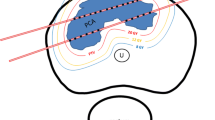Background:
Evaluation of feasibility, tolerance and efficiency for a new 3D interstitial HDR brachytherapy technique combined with 3D external beam radiotherapy and androgen deprivation for prostate cancer.
Patients and Methods: Between January 1997 and August 1998 we treated 35 patients with Stage cT1–3 N0 M0 prostate cancer. Thirty-two patients with a follow-up of 12 to 28 months (median: 18 months) were evaluated. After ultrasound-guided transrectal implantation of 4 non-parallel needles, CT based 3D brachytherapy treatment planning (“Offenbach system”) was performed. All patients received 4 fractions brachytherapy using a fractional dose of 5 or 7 Gy. Time between each fraction was 14 days. After brachytherapy 3D external irradiation followed up to 39.6 or 45.0 Gy. All patients received androgen deprivation, starting 2 to 19 months before brachytherapy, ending 3 months after 3D external radiotherapy.
Results: Posttreatment PSA levels dropped to < 1.5 ng/ml in 29/32 patients (91%). In 25 patients PSA levels were < 0.5 ng/ml, in 4 patients 0.5 to 1.5 ng/ml. In 2 patients we noted biochemical relapse. Transrectal implantation was very well tolerated. Grade 3 acute urinary toxicity occurred in 1 patient. We noted no Grade 2 or higher acute gastrointestinal toxicity. One patient developed a Grade 3 late urinary toxicity. No patient showed late gastrointestinal side effects. All 140 dose-volume histograms for 3D HDR brachytherapy were analyzed.
Conclusions: The new 3D HDR brachytherapy technique, combined with 3D external irradiation and androgen deprivation, is a feasible, so far well tolerated and effective treatment in the short-time follow-up of median 18 months.
Hintergrund:
Auswertung der Praktikabilität, Verträglichkeit und Effektivität einer neuen interstitiellen 3D-HDR-Brachytherapie-Technik, kombiniert mit externer 3D-Radiotherapie und Androgendeprivation beim Prostatakarzinom.
Patienten und Methoden: Von Januar 1997 bis August 1998 behandelten wir 35 Patienten mit Prostatakarzinomen im Stadium cT1–3 N0 M0. Die Daten von 32 Patienten mit einer Nachbeobachtungszeit von zwölf bis 28 Monaten (median: 18 Monate) wurden ausgewertet. Nach ultraschallgesteuerter transrektaler Implantation von vier nicht parallelen Nadeln erfolgte die CT-gestützte 3D-Brachytherapie-Planung (“Offenbach-System”). Alle Patienten erhielten vier Fraktionen der 3D-Brachytherapie mit einer Einzeldosis von 5 oder 7 Gy im Abstand von jeweils 14 Tagen. Anschließend erfolgte die externe 3D-Radiotherapie bis 39,6 oder 45,0 Gy. Alle Patienten erhielten zusätzlich eine Androgendeprivation, die zwei bis 19 Monate vor der Brachytherapie eingeleitet und drei Monate nach Abschluss der externen Radiotherapie abgesetzt wurde.
Ergebnisse: Bei 29/32 Patienten (91%) sank der posttherapeutische PSA-Wert unter 1,5 ng/ml, davon bei 25 Patienten auf unter 0,5 ng/ml, bei vier Patienten auf 0,5 bis 1,5 ng/ml. Zwei Patienten entwickelten ein biochemisches Rezidiv. Die transrektale Implantation wurde sehr gut toleriert. Ein Patient entwickelte akute Grad-3-Toxizitäten des Harntraktes, kein Patient akute gastrointestinale Nebenwirkungen größer als Grad 1. Eine Grad-3-Spättoxizität des Harntraktes zeigte ein Patient, gastrointestinale Spättoxizitäten entwickelte kein Patient. Alle 140 Dosis-Volumen-Histogramme der 3D-HDR-Brachytherapie wurden ausgewertet.
Schlussfolgerung: Die neue 3D-HDR-Brachytherapie-Technik, kombiniert mit externer 3D-Radiotherapie und Androgendeprivation, stellt eine praktikable, bisher gut verträgliche und effektive Therapiemodalität nach Kurzzeitnachbeobachtung von median 18 Monaten dar.
Similar content being viewed by others
Author information
Authors and Affiliations
Additional information
Submitted: 7 Feb 2000; accepted: 12 May 2000
Rights and permissions
About this article
Cite this article
Martin, T., Hey-Koch, S., Strassmann, G. et al. 3D Interstitial HDR Brachytherapy Combined with 3D External Beam Radiotherapy and Androgen Deprivation for Prostate Cancer Preliminary Results. Strahlenther Onkol 176, 361–367 (2000). https://doi.org/10.1007/PL00002344
Issue Date:
DOI: https://doi.org/10.1007/PL00002344




